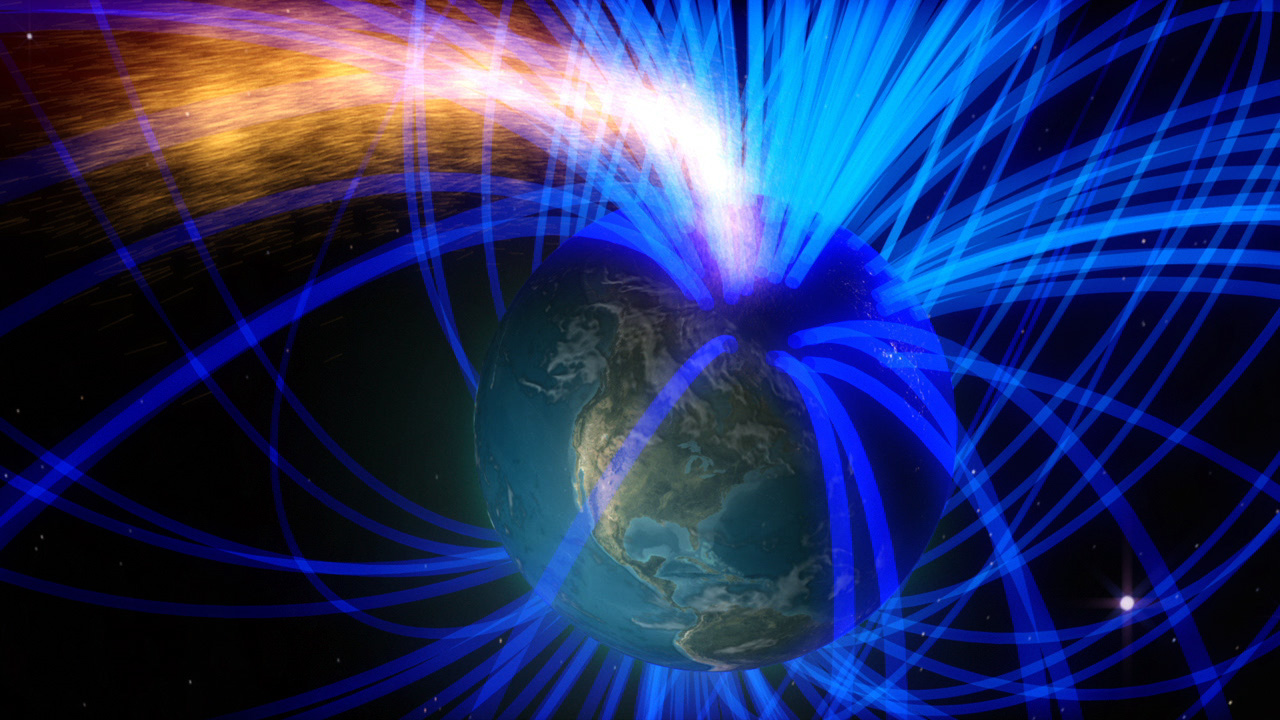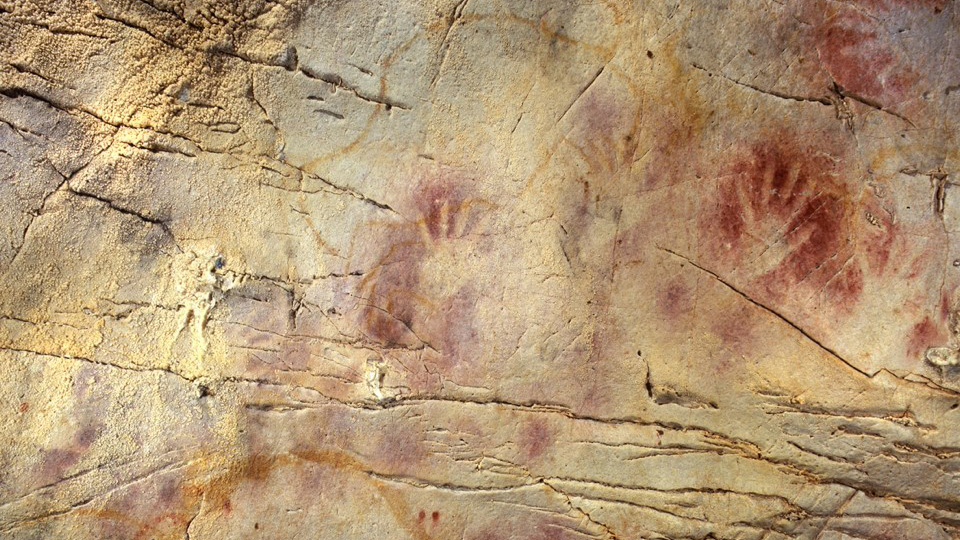Earth's magnetic field flipped 42,000 years ago, creating a climate 'disaster'
See you on the flip side.

A reversal in Earth's magnetic field thousands of years ago plunged the planet into an environmental crisis that may have resembled "a disaster movie," scientists recently discovered.
Our planet's magnetic field is dynamic and, numerous times, it has flipped — when the magnetic North and South Poles swap places. In our electronics-dependent world, such a reversal could seriously disrupt communication networks.
But the impact could be even more serious than that, according to the new study. For the first time, scientists have found evidence that a polar flip could have serious ecological repercussions. Their investigation connects a magnetic field reversal about 42,000 years ago to climate upheaval on a global scale, which caused extinctions and reshaped human behavior.
Related: What if Earth's magnetic field disappeared?
Incredible Earth: $22.99 at Magazines Direct
The planet we live on is a remarkable place. But have you ever wondered how or why these things occur? How the Earth was made? How we predict the weather? How fossils form? What causes earthquakes or which animals glow in the dark? "Incredible Earth" reveals answers to these questions and more on a thrilling journey through everything you need to know about our world — and with gorgeous photography and insightful diagrams along the way!
Earth's magnetosphere — the magnetic barrier surrounding the planet — originates from the churning of hot, molten metal around its iron core. This perpetually sloshing liquid flow generates electricity that in turn produces magnetic field lines, which curve around the planet from pole to pole, according to NASA.
Like a protective bubble, the magnetic field shields Earth from solar radiation. On the planet's sun-facing side, constant bombardment from solar winds squishes the magnetic field, so that the field extends to a distance no more than 10 times Earth's radius. However, on the side of the planet facing away from the sun, the field extends much farther into space, forming an enormous "magnetotail" that reaches beyond our moon, NASA says.
Marking the two spots on Earth where arcing magnetic field lines converge are the magnetic North Pole and South Pole. But while these positions are relatively stable, the poles — and the magnetic field itself — aren't fixed in place. About once every 200,000 to 300,000 years, the field weakens enough to reverse polarity completely. The process can take hundreds or even thousands of years, according to NASA.
Sign up for the Live Science daily newsletter now
Get the world’s most fascinating discoveries delivered straight to your inbox.
Magnetic molecules preserved in volcanic deposits and other sediments tell scientists when past reversals happened; those molecules align with the magnetic field at the time that they were deposited, so they indicate the location of the magnetic North Pole, said lead study author Alan Cooper, an emeritus professor in the Department of Geology at the University of Otago in New Zealand.
Recently, researchers questioned whether a relatively recent and brief polarity reversal called the Laschamps Excursion, which took place between 41,000 and 42,000 years ago, could be linked to other dramatic changes on Earth from that time, which had not previously been attributed to activity in the magnetosphere. They suspected that during a time when our protective magnetic field was reversing — and thereby weaker than normal — solar and cosmic radiation exposure could affect the atmosphere enough to impact climate, the study authors reported.
Clues in "biscuits"
Prior studies of Greenland ice cores dating to Laschamps didn't reveal evidence of climate change, according to the study. But this time, the researchers turned their attention to another potential source of climate data: bog-preserved kauri trees (Agathis australis) from northern New Zealand.
They cut cross-sections, or "biscuits," from the preserved trunks, and looked at changes in levels of carbon 14, a radioactive form of the element, over a period that included the Laschamps reversal. Their analysis revealed elevated levels of radioactive carbon in the atmosphere during Laschamps, when the magnetic field was weakening.
"Once we worked out the exact timing from the kauri record, we could see that it coincided perfectly with records of climatic and biological change all over the world," Cooper told Live Science in an email. For example, around this time, megafauna in Australia began to go extinct and Neanderthals in Europe were dying out; their decline may have been accelerated by climate-related changes to their ecosystems, Cooper said.
The authors then used computer climate models to test what may have caused widespread climate upheaval and related extinctions. They found that a weak magnetic field — operating at about 6% of its normal strength — could lead to major climate impacts "via the ionizing radiation strongly damaging the ozone layer, letting in UV [ultraviolet rays] and altering the ways in which the sun's energy was absorbed by the atmosphere," Cooper explained.
A heavily ionized atmosphere could also have generated brilliant auroras around the world and produced frequent lightning storms, making skies look like "something similar to a disaster movie," Cooper said.

Another significant shift around that time was in Homo sapiens, with cave art beginning to appear in locations around the world. This included the first examples of red ochre hand stencils, "which we suspect is actually a sign of the application of sunscreen," a practice still seen in modern Indigenous groups in Namibia, Cooper said. Higher UV levels from a weak magnetic field could have driven humans to seek shelter in caves, or forced them to protect their skin with sunblocking minerals, he said.
Scientists can't predict precisely when the next reversal of our magnetic field might happen. However, some signs — such as the North Pole's current migration across the Bering Sea area and the magnetic field itself weakening nearly 10% over the past 170 years — suggest that a flip may be closer than we think, making it more urgent that researchers fully understand how big shifts in our magnetic field could shape environmental changes on a global scale, according to the study.
"Overall, these findings raise important questions about the evolutionary impacts of geomagnetic reversals and excursions throughout the deeper geological record," the scientists wrote.
The findings were published online Feb. 18 in the journal Science.
Originally published on Live Science.

Mindy Weisberger is an editor at Scholastic and a former Live Science channel editor and senior writer. She has reported on general science, covering climate change, paleontology, biology and space. Mindy studied film at Columbia University; prior to Live Science she produced, wrote and directed media for the American Museum of Natural History in New York City. Her videos about dinosaurs, astrophysics, biodiversity and evolution appear in museums and science centers worldwide, earning awards such as the CINE Golden Eagle and the Communicator Award of Excellence. Her writing has also appeared in Scientific American, The Washington Post and How It Works Magazine. Her book "Rise of the Zombie Bugs: The Surprising Science of Parasitic Mind Control" will be published in spring 2025 by Johns Hopkins University Press.










